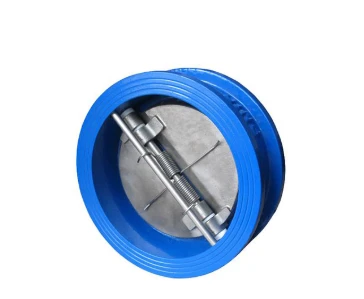Feb . 08, 2025 03:06
Butterfly valves, especially those rated at PN 16, play a critical role in a myriad of industrial applications, offering a blend of efficiency, reliability, and cost-effectiveness. When delving into the specifics of butterfly valves PN 16, it’s essential to understand the technical nuances and practical applications that make them indispensable in modern industry.

An understanding of the PN 16 specification is foundational. PN, short for Pressure Nominal, is a European designation that indicates the pressure rating of the valve, in this case, 16 bar. This makes the butterfly valve suitable for moderate pressure applications, offering versatility across various sectors such as water treatment, oil and gas, chemical processing, and HVAC systems.
From a practical standpoint, the butterfly valve's unique design grants it an edge over other valve types. Its disc, positioned in the center of the pipe, rotates with the quarter turn of a rod connected to an actuator. This simple yet effective mechanism allows for rapid opening and closing, resulting in enhanced flow control and reduced pressure drop. Such characteristics are particularly beneficial in large flow applications where precision and efficiency are paramount.

The construction of the PN 16 butterfly valve underscores its robustness. Typically, the valve’s body is crafted from durable materials such as stainless steel, ductile iron, or carbon steel, ensuring longevity even under demanding conditions. The choice of material often depends on the specific application, as factors like temperature, flow medium, and environmental conditions play a pivotal role in determining the most suitable composition.
From the lens of expertise, selecting the right actuator for a butterfly valve is crucial. Manual, electric, pneumatic, or hydraulic actuators each offer distinct advantages. For instance, pneumatic actuators are preferred in explosive environments due to their non-electric nature, while electric actuators offer precision and ease of automation, ideal for systems requiring remote operation and integration with other control systems.
Authoritativeness in the butterfly valve sphere is often established through adherence to stringent industry standards. Certification from recognized bodies such as ISO, API, or DIN not only assures quality but also instills confidence among end-users. Manufacturers that comply with these standards are typically viewed as reliable partners, capable of delivering solutions that meet stringent operational demands.
butterfly valve pn 16
Trustworthiness, a cornerstone of consumer confidence, is enhanced by transparent dealings and a track record of reliability. Testimonials, case studies, and documented performance metrics of PN 16 butterfly valves can provide invaluable insights into their operational efficacy. For instance, showcasing a case where a butterfly valve has successfully operated over extensive periods without failure can substantiate claims of durability and cost-effectiveness.
Integrating butterfly valves PN 16 into an industrial system often presents opportunities for cost savings and efficiency gains. Their design ensures minimal maintenance, reducing downtime and operational costs. Additionally, the ease of installation and compact size make them suitable for applications where space is at a premium.
When considering a purchase, it is advisable to consult with experts or engineers who can provide tailored recommendations based on specific system requirements. This strategic approach ensures that the chosen valve not only meets present needs but also mitigates potential future challenges.
Lastly, the incorporation of technology, such as IoT, into butterfly valves is transforming the landscape, offering real-time monitoring and diagnostics. This enables predictive maintenance, further enhancing reliability and performance.
In conclusion, butterfly valves PN 16 represent a critical component in achieving optimal flow control across various industries. Their blend of durability, efficiency, and adaptability ensures their continued relevance, making them a wise choice for today's dynamic industrial challenges. Leveraging the insights of experienced professionals and embracing technological advancements will undoubtedly continue to elevate their performance and application scope.


 Call us on:
+86-311-86935302
+86-311-86935302
Call us on:
+86-311-86935302
+86-311-86935302
 Email Us:
info@thriveonvalve.com
Email Us:
info@thriveonvalve.com South of Huanmadian Village Town, Ningjin County, Xingtai, Hebei Province, China
South of Huanmadian Village Town, Ningjin County, Xingtai, Hebei Province, China